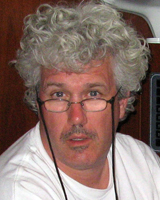Dr. Paul A. Walton

Associate Professor
Ph.D. University of Western Ontario
B.Sc. Bishop's University
Office: 474 Medical Sciences Building
Phone: 519-661-2111 Ext. 86825
Fax: 519-661-3936
Email: pwalton@uwo.ca
Research Interests:
Import of proteins across the peroxisomal membrane.
Peroxisomes produce hydrogen peroxide as a product of their oxidative enzymes, and possess the antioxidant enzyme catalase to decompose this damaging compound. Under normal conditions, catalase is imported into the peroxisomes, using a variant (-KANL) of the canonical carboxy-terminal peroxisomal targeting signal (-SKL). While the targeting signal of catalase is less efficient, it is sufficient to provide targeting under normal conditions. My colleagues and I have demonstrated that this targeting becomes less efficient as cells and animals age; leading to the exclusion of catalase from the peroxisome. This loss of the primary antioxidant from the peroxisome leads to the accumulation of hydrogen peroxide in aged cells and animals. This increase in cellular hydrogen peroxide leads the specific redox changes, and non-specific damage to cellular constituents.
We have recently demonstrated that, because of the seemly inefficient targeting signal, catalase is retained in the cytosol under conditions of oxidant stress. The catalase is able to metabolize hydrogen peroxide in the cytosol under these conditions. Following restoration of normal cellular redox state, catalase is subsequently imported into the peroxisome. Thus, the inefficient targeting signal leads to a method of controlling the subcellular distribution of an important antioxidant molecule.
Effects of aging on peroxisomal protein import.
We have demonstrated that import of catalase into the peroxisomal matrix is reduced as cells age. My lab and the laboratories of my collaborators are studying whether a decrease in catalase contributes to cellular aging. In addition, we are studying the effects of restoring catalase to the peroxisome on free-radical levels, peroxisome and cellular functions, and neuroprotection in animal models.
Collaborations:
We collaborate with members of the Allman Laboratory on the use of catalase in the protection against hearing loss due to chemotherapeutics and aminoglycoside antibiotics. We also collaborate with members of the Whitehead Laboratory on the effects of exosomally delivered catalase in animal models of Alzheimer’s Disease.
Selected Publications:
-
Walton, P.A., Brees, C., Lismont, C., Apanasets, O., and Fransen, M. (2017) The peroxisomal import receptor PEX5 functions as a stress sensor, retaining catalase in the cytosol in times of oxidative stress. Biophys. Acta – Molecular Cell Research 1864, 1833-1843.
-
Nell, H.J., Au, J.L., Giordano, C.R., Wang, L., Terlecky, S.R., Walton, P.A., Whitehead, S.N., and Cechetto, D.F. (2016) Targeted antioxidant, Catalase-SKL, reduces beta-amyloid toxicity in the rat brain. Brain Pathology doi:10.1111/bpa.12368
-
Giordano, C.R., Terlecky, L.J., Bollig-Fischer, A., Walton, P.A., and Terlecky, S.R. (2014) Amyloid-beta Neuroprotection Mediated by a Targeted Antioxidant. Scientific Reports (Nature) 4, doi:10.1038/srep04983
-
Walton, P.A. and Pizzitelli, M. (2012) Effects of peroxisomal catalase inhibition on mitochondrial function. Frontiers in Integrative Physiology 3, 108-117.
-
Koepke, J.I., Wood, C.S., Terlecky, L.J., Walton, P.A. and Terlecky, S.R. (2008) Progeric effects of catalase inactivation in human cells. Toxicology and Applied Pharmacology 232: 99-108.
-
Koepke, J.I., Nakrieko, K.A., Wood, C.S., Boucher, K.K., Terlecky, L.J., Walton, P.A. and Terlecky, S.R. (2007) Restoration of peroxisomal catalase import in a model of human cellular aging. Traffic 8: 1590-1600.
-
Terlecky, S.R., Koepke, J.I., and Walton, P.A. (2006) Peroxisomes and Aging. Biochim. Biophys. Acta-Molec. Cell Res. 1763: 1749-1754.
-
Wood, C.S., Koepke, J.I., Teng, H., Boucher, K.K., Chang, P., Katz, S., Terlecky, L.J., Papanayotou, I., Walton, P.A. and Terlecky, S.R. (2006) Hypocatalasemic fibroblasts accumulate hydrogen peroxide and display age-related pathologies. Traffic 7: 1-11.
-
Brocard, C.B., Boucher, K., Jedeszko, C., Kim, P. and Walton, P.A. (2005) Requirement for microtubules and dynein-motors in the earliest stages of peroxisome biogenesis. Traffic 6: 386-395 (includes cover illustration)
-
Terlecky, S.R. and Walton, P.A. (2004) The Cell Biology and Biogenesis of Peroxisomes in Human Health and Disease. In: The Biogenesis of Cellular Organelles . Mullins, C., editor, Landes Bioscience Publishing Company, Georgetown, Texas.
-
Brocard, C.B., Jedeszko, C., Song, H.C., Terlecky, S.R. and Walton, P.A. (2003) Protein structure and import into the peroxisomal matrix. Traffic 4: 74-82
-
Legakis, J.E., Koepke, J.I., Jedeszko, C., Barlaskar, B., Terlecky, L.J., Edwards, H.J., Walton, P.A. and Terlecky, S.R. (2002) Peroxisome senescence in human fibroblasts. Molec. Biol. Cell 13: 4243-4255 (includes cover illustration)
-
Walton, P.A., Hill, P.E., and Subramani, S. (1995) Import of stably-folded proteins into peroxisomes. Molec. Biol. Cell 6: 675-683.








